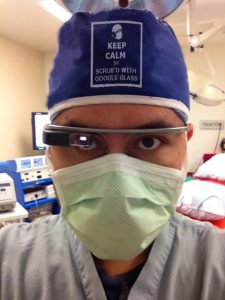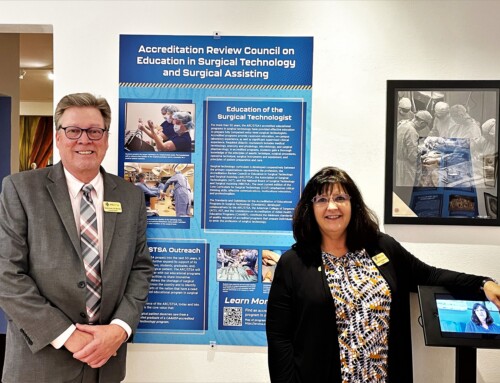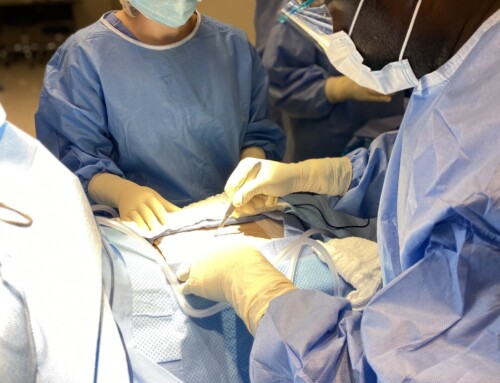Technology – particularly, robotics – is becoming an integral part of surgery. While practices in the operating room rapidly advance, there is concern that classrooms are not keeping up. Realistically, however, program directors cannot invest in expensive equipment – so how can students be better prepared?
In our May/June newsletter, we shared an educator’s perspective, from Dr. Joseph B. Long, CST, FAST, a lead faculty member at Lansing Community College. Now hear from John C. Springer, CST, lead surgical technologist in Head and Neck Surgery at Keck Hospital of USC, who weighs in with his 10 years of clinical experience and observations.
The discussion around technology and education is one that is here to stay and will continue to evolve. We invite you to continue the discussion with us on Facebook or LinkedIn.
Fighting Fire With Fire – Using Technology to Solve Problems Created by Technology
By John C. Springer, CST, Lead in Head and Neck Surgery, Keck Hospital of USC
Technology has revolutionized the perioperative arena. The onset of minimally invasive surgery paved the way for the development of natural orifice endoscopic surgery, laparoscopic procedure and robotic surgical techniques. Surgical technology clinicians have witnessed and personally experienced this paradigm shift and change that transformed our very own domain – the surgical environment.
As a practicing surgical technologist, however, I believe we are not evolving quickly enough when it comes to technological literacy and keeping pace with the rest of the surgical team. This is a real dilemma and more apparent among emerging surgical technology professionals (i.e. students), due to limited, or a lack of, opportunities to experience computer and technology-based surgical equipment while training.
Realistically it is not practical for a surgical technology program to purchase surgical equipment, such as robots, to train their students. However, there are other options that can better help prepare our students. As a clinician and a surgical technology student preceptor, here are a few elements that are crucial to achieving this objective and should be integrated into surgical technology programs’ curriculum and training methods.
The History of Surgical Technology
One element is the students’ levels of cognition, comprehension and engagement. Although they may be knowledgeable in other aspects of learning, they are less inclined to participate and interact in discussions about the diagnosis of a disease and the history of surgical intervention. This is especially true when it comes to minimally invasive and computer-assisted cases.
Our students study anatomy and physiology, but how much do they know about the procedure, its past, its evolution and how the technology has revolutionized the surgical outcome? This information drives curiosity and interest, instead of emphasizing the “hype” of new technology. There is, after all, a different reality that robotics bring into the operating room, in relation to the traditional method of surgical intervention. It condenses a surgical procedure to a bare minimum, thus the name minimally invasive approach. For a student who is trained to know every surgical instrument on a major tray for a big abdominal case, or powered tools in an orthopedic case, the experience of coming into a room to double scrub in a minimally invasive procedure with little instrumentation and minimal set-up can be less interesting and become mundane. This is when apprehension turns into disappointment, interest into disregard, and curiosity into boredom. When asked for feedback and their first impression of the robotic procedure in which they participated, many surgical technology students will express less fascination and awe than for more traditional procedures.
Augmenting Learning Through Augmented Reality
 Adopting technology itself is another way to help improve the skill set of a surgical technology student. Access to information is literally at our fingertips or, with Google Glass, in our face.
Adopting technology itself is another way to help improve the skill set of a surgical technology student. Access to information is literally at our fingertips or, with Google Glass, in our face.
Wearable devices and smart gadgets that create a simulated or virtual environment and support augmented reality are among the emerging technology options available, in lieu of the expensive simulators or the actual equipment itself. In 2013, I became part of the Google Glass Explorer program and the first surgical technologist to use Google Glass Explorer. I believe this technology could change the way we teach and train surgical technologists, by performing real-time and interactive demonstrations. While there are some drawbacks to this device specifically – limited availability, data security and patient privacy chief among them – it is a step in the right direction and a reminder to continue pursuing and testing innovative solutions.
In our current healthcare system, there is a continued push for efficiency and a demand for competent and smart healthcare professionals. Before we can further advance as professionals, we need to think like our fellow professionals. We need to adapt current and smart technology to be relevant to our changing industry and working environment.
It may be time to fight fire with fire, using technology to solve challenges created by technology. There is an opportunity here to not just train our students in cognitive, psychomotor and affective skills, but to effectively equip them with technology that propels their careers into the future.
 John C. Springer, CST, has 10 years of clinical experience as a certified surgical technologist lead in head and neck surgery, specializing in TransOral robotic surgery at Keck Hospital of USC. His exploration with the wearable technology, Google Glass, has helped develop augmented and virtual reality teaching concepts to enhance the competency and skills of the surgical technologist. You can learn more about his exploration in an article he wrote for The Surgical Technologist in July of 2016, “Keep Calm! I’m scrubbed in with Google Glass.”
John C. Springer, CST, has 10 years of clinical experience as a certified surgical technologist lead in head and neck surgery, specializing in TransOral robotic surgery at Keck Hospital of USC. His exploration with the wearable technology, Google Glass, has helped develop augmented and virtual reality teaching concepts to enhance the competency and skills of the surgical technologist. You can learn more about his exploration in an article he wrote for The Surgical Technologist in July of 2016, “Keep Calm! I’m scrubbed in with Google Glass.”



